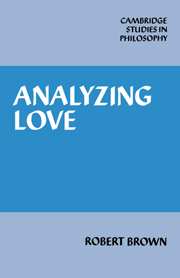Summary
Love is commonly reckoned to be one emotion among many. But how many emotions we think there are depends on what account we adopt of the necessary and sufficient conditions for something to be an emotion. If we think that emotions are simply our awareness of the physiological changes produced in us by our perception of certain sorts of objects, then we can try to count the different sorts of objects that are capable of causing these bodily sensations in us: for example, frightening objects, extraordinary objects, delightful ones. Or we can try to count emotions by distinguishing the different patterns of these physiological changes that certain sorts of objects and situations produce in us: in sorrow, irregular heart beats combined with weeping and trembling, for instance. However, if the view adopted is the one that we shall employ here, an emotional state consists in abnormal bodily changes caused by the agent's evaluation or appraisal of some object or situation that the agent believes to be of concern to him or her. Distinguishing such states from each other, and hence counting them, will require us to distinguish the different kinds of evaluations and appraisals embedded in them – evaluations, for example, of situations as being inexplicably strange or embarrassing or pathetic or pitiful or appealing. Since not all societies make these same sorts of evaluations, some emotions named and recognized in one society can be nameless and unfamiliar in another. Thus the German Schadenfreude, or malicious glee, is a response that is familiar outside Germany but perhaps not common enough in some societies for it to be classified by their members as an ordinary emotion.
- Type
- Chapter
- Information
- Analyzing Love , pp. 14 - 46Publisher: Cambridge University PressPrint publication year: 1987



